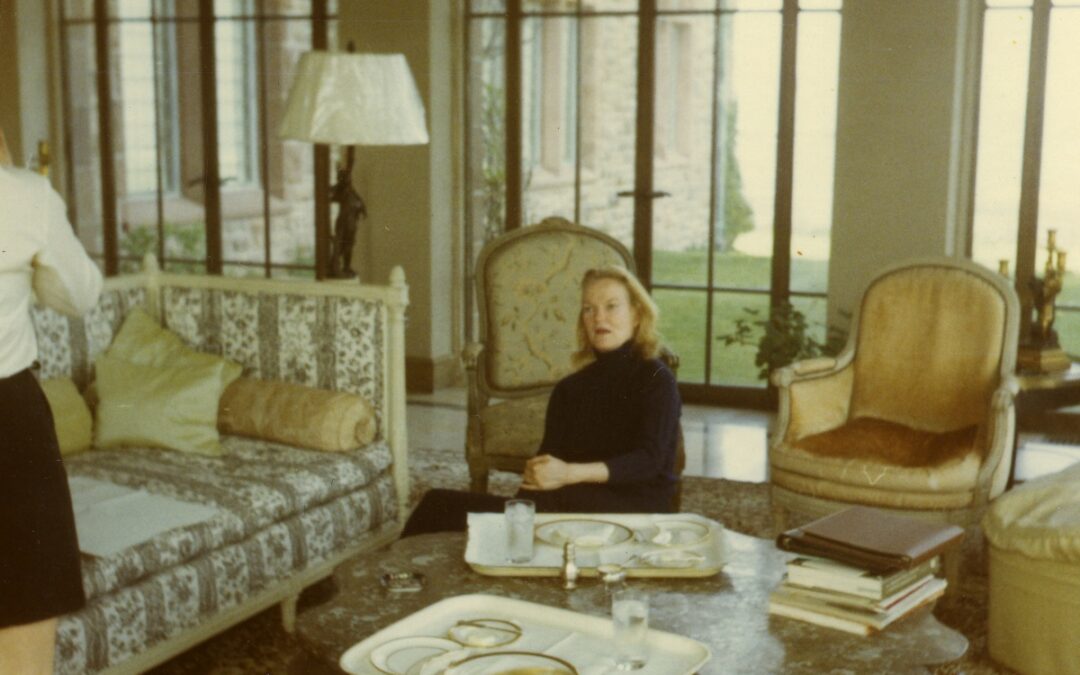
by NRF User | Mar 21, 2019 | NRF News
At Rough Point, the questions asked most by visitors are not always about the priceless artworks, the architecture, or the history of the building. The questions most frequently asked are about the estate’s most recent owner: heiress, preservationist, and art collector, Doris Duke. The inquisitive interest in this unconventional heiress became the inspiration behind this year’s exhibition, Beyond Fortune: The Life & Legacy of Doris Duke.
Like many public figures, much of Doris’s life played out on the pages of tabloids and gossip columns, creating a popular memory of her made of half-truths that overshadow her unique character, commitment to historic preservation, and her generosity and patronage of a variety of charitable efforts. Visitors to the museum who already know of Doris Duke, and even those who do not, are always curious to learn more about her life outside of the spotlight.
This year’s exhibition poses the question, “What do we really know about Doris Duke?” Using historical documents and photographs from the Doris Duke Historical Archives at the David Rubenstein Library at Duke University and items from the Rough Point art and fashion collection, we are inviting visitors to learn more about Doris by looking honestly at her interests, complexities, and eccentricities to see beyond the myths and legends often associated with her life.
In anticipation of the exhibition, we have asked the staff to share six questions they receive most from visitors at Rough Point and their answers:
How old was Doris Duke when she inherited her fortune, and what was her net worth?
Doris Duke became the “richest little girl in the world” at the age of 12 when she inherited $80 million after the death of her father, the tobacco magnate, James B. Duke. When he passed, he set up a complex trust that provided her inheritance to be released in installments at ages 18, 21, and 25. When Doris died in 1993, her estate was worth $1.2 billion.
Was Doris Duke married?
Doris Duke married and divorced twice, and had several other serious relationships during her lifetime. Doris’s first husband, James Cromwell (1896-1990), was a divorcee and 16 years older when they met in 1929. They married in 1935 and divorced eight years later. Cromwell was politically ambitious and was named Ambassador to Canada by President Franklin D. Roosevelt in 1940. He ran unsuccessfully for US Senator from New Jersey in 1946. Doris’s second husband, Porfirio Rubirosa, was a Dominican diplomat and international playboy who married five times. They met in Rome in 1945 and married in September 1947—the pair divorced just a year later in October 1948.
Did Doris Duke have any children?
Doris had a daughter, Arden, who was born prematurely on July 11, 1940. Sadly, Arden only lived a day and Doris was unable to have other children. Based on telegrams and phone records from that time, Alec Cunningham-Reid was likely the father, not James Cromwell.
Doris Duke met Chandi Heffner in 1985 and felt a strong maternal connection to Her. She formally adopted Heffner in 1988. They maintained a familial relationship until 1990 when Doris Duke disinherited Heffner.
When did she live at Rough Point?
Although the Duke family purchased Rough Point in 1922, the family did not spend much time here between the late 1930s and the late 1950s. Beginning in 1958, Doris Duke re-occupied Rough Point and re-furnished the house. For the remainder of her life, Doris spent an extended “season” here at Rough
Point (from roughly April to November). She continued to refine the collection and the arrangement of the rooms at Rough Point throughout her life. Today, the museum features objects, furniture, and art selected, arranged, and used by Doris to make Rough Point a home.
Were there really camels at Rough Point?
In the late 1980s, Doris decided to purchase a Boeing 737 aircraft. As part of the negotiations it was agreed that the seller would include two Bactrian camels. Interestingly enough, Doris herself found two baby camels at the J.C. Schulz game farm in Catskill, New York and was reimbursed by the aircraft seller (since this was part of contractual legal obligation). That’s how in 1988, Baby and Princess came to live at Rough Point. Summers were spent in a tent on the terrace and they spent winters in a heated stable at Duke Farms. Contrary to popular rumors, no mysterious Sheiks were involved in acquiring the camels.
How did Doris Duke pass away?
In 1992, Doris broke her hip, then had both knees replaced in early 1993, and suffered a stroke in July 1993. She died at home in Beverly Hills, CA on October 28, 1993 at the age of 80. The official cause of death was progressive pulmonary edema, leading to cardiac arrest.
Do you have more questions about Doris Duke? Visit Rough Point this year as we tackle many more ideas and myths about her life in the exhibition and our public programming throughout the season. Beyond Fortune: The Life & Legacy of Doris Duke will be on exhibit in the galleries at Rough Point Museum from Tuesday, April 2, through Sunday, November 17, 2019. The museum is open Tuesday – Sunday, from 10:00 am to 5:00 pm and Wednesdays until 7:00 pm beginning April 2. Click here to plan your visit today!
Photo courtesy of Doris Duke Charitable Foundation Historical Archives, David M. Rubenstein Rare Book & Manuscript Library, Duke University, Durham, North Carolina.

by CC:S MY | Mar 3, 2019 | NRF News
As a scholar of the late nineteenth and early twentieth centuries, but one who has—until recently—had little opportunity to spend time in New England, I have developed a particular, though less than fully informed, vision of the wealthy women and men who called Newport their summer home and what their so-called summer cottages must have looked like. In my mind’s eye, the people of the past who called Bellevue Avenue their summer home have always appeared to me as a fairly uniform lot of stern looking men in dark suits and elegantly attired, but severely corseted, women with elaborate hairdos. When I have allowed myself the time to imagine the Bellevue Avenue homes, I have conjured up images of first floors filled with an endless series of grand rooms, each with sweeping views of the Atlantic and geometrically perfect parquet floors. Upstairs I imagined bedrooms covered in heavy rugs and carpeting and windows covered and framed in even heavier drapery. In short, I always envisioned the Bellevue Avenue Historic District and its former residents as archetypes of the Gilded Age and the Progressive era. That all changed the first time I saw Doris Duke’s bedroom.
If you’ve never seen the room before, please take a look at the images that accompany this blog. It is extraordinary. I first saw it in person during my final interview for the Director of Museums position at the NRF, and it quickly became my favorite room at Rough Pont (still is). Bright yellow walls (originally painted purple) serve as an exciting visual counterpoint to brilliant purple curtains. The room is filled with exquisite furniture upholstered in similarly vibrant purple fabrics and oftentimes faced with the most remarkably iridescent mother of pearl—a favorite decorative material of Doris Duke’s both here at Rough Point and in her Shangri La home in Hawaii. Despite the age of the pieces, most of which date to the nineteenth century, the visual impact of the room suggests a particular vision of modernity and fashion quite familiar to those of us born and raised in the second half of the twentieth-century, which is when Miss Duke decorated the room. Her choices of fabric and furniture created a visual aesthetic that linked the past and her present in surprising and visually stunning ways.
Doris Duke lived at Rough Point off and on until about a year before her death in 1993. At the Newport Restoration Foundation, we are deeply committed to sharing with visitors a sense of how Miss Duke lived at Rough Point over the last few decades of her life. Consequently, our collections, as well as the ways in which we exhibit them, often juxtapose the design and collecting practices of the Gilded Age and Progressive era (her parents’ generation) with the lived experience of an entirely different age. In some sense, Rough Point is the place where the 1880s and 90s meet the 1980s and 90s, and this mixing of centuries proves quite evident in Doris Duke’s Bedroom, which includes items like a delicate and deeply expressive Renoir painting of a young woman from 1875 and an AT&T Merlin telephone system (an iconic business phone system of the 1980s and a frequent feature in the rooms at Rough Point).

Pierre-Auguste Renoir (French, 1841-1919), Jeune fille blonde cousant, 1875, 1999.496.
To my mind, this linking of past and present, or at least the linking of a more and less distant past, is what distinguishes Rough Point from many of its neighboring historic home tours, and I am pleased to say that when one reads the online reviews, our visitors find the same thing to be true. Former visitors’ reviews note that we’re not like the other mansions on Bellevue. While visitors to Newport are powerfully impressed by the grandeur of the neighboring mansions (as well they should), they note that our home, Rough Point, feels more accessible and more relatable. Perhaps my favorite review noted that Rough Point was “the only mansion that we actually felt like we could live in.”
As someone who spends most of his working days at Rough Point, I think I understand what that reviewer was trying to say. Despite its grandeur and extraordinary beauty, there’s a sense of hominess at Rough Point, a wonderful, comfortable feeling that comes from the pairing of extraordinary works of European art and furniture from a more distant past with the mundane artifacts of day to day life in the mid to late 20th century. That duality, if you will, is directly attributable to Miss Duke and the life that she lived at Rough Point. You can find examples of this throughout the house, from the kitchen, which displays a lively pairing of late 20th century appliances with amenities from earlier in the century (including a sizeable, porcelain-tiled humidor built around 1900 to accommodate “Buck” Duke’s considerable cigar habit); to the pine room, which boasts an 18th century mirror (purchased in a Paris flea market!) and a Sony reel to reel tape recorder from the second half of the 20th century; and of course to Miss Duke’s bedroom, my favorite room at Rough Point.
 Humidor, Wilke Manufacturing Company, Anderson, Indiana (American, 1897-1905). United States, ca. 1900. Porcelain tiles, nickel, wood, P2018.1.
Humidor, Wilke Manufacturing Company, Anderson, Indiana (American, 1897-1905). United States, ca. 1900. Porcelain tiles, nickel, wood, P2018.1.

The Pine Room at Rough Point
I hope that you’ll find the time to visit Rough Point this season and see these rooms (and many others) for yourself. While I encourage everyone to view our website, which shares some images of each room on display, there really is no substitute for experiencing the home in person. Whether you visit the mansion physically or virtually, I encourage you to share your favorite room with us on social media by using the hashtag #myfavoriteroomatrp. I look forward to seeing your photographs and comments.
By Erik Greenberg, Ph.D., Director of Museums, Newport Restoration Foundation
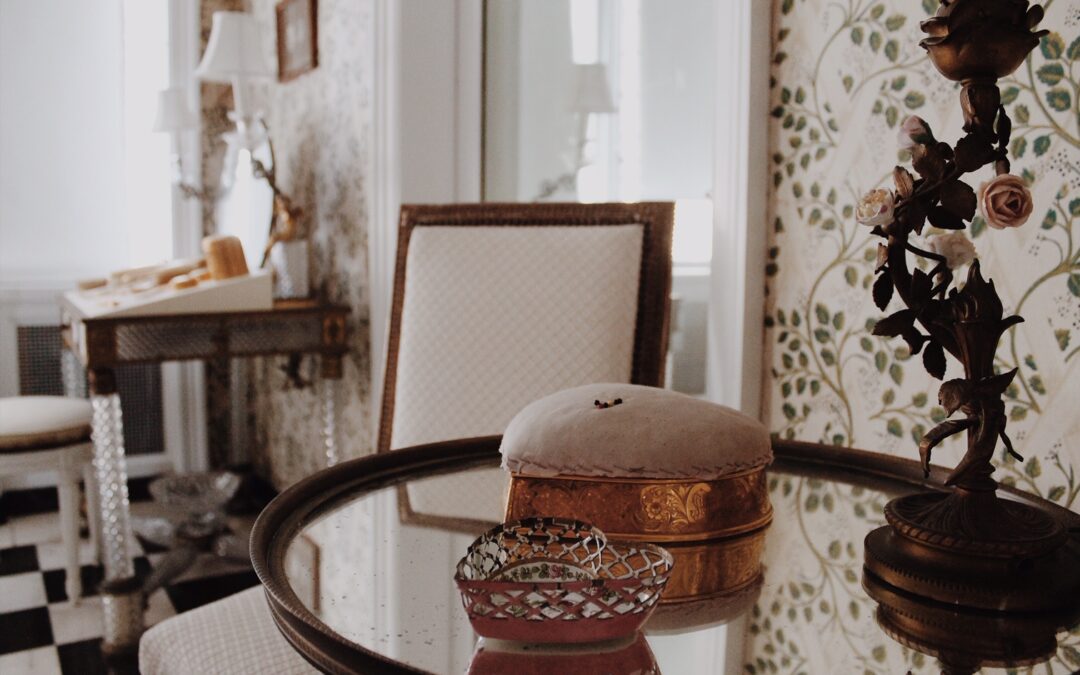
by CC:S MY | Feb 14, 2019 | NRF News
Hearts may not have been one of Doris Duke’s favorite design motifs, but heart shapes can be found in several places throughout her Newport estate. In honor of Valentine’s Day, we’re taking a closer look at some of the hidden hearts in the fine and decorative arts collection at Rough Point.
A Desk to Adore

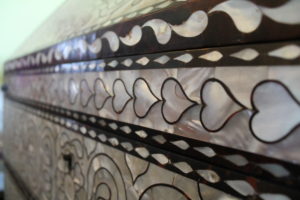
Desk and bookcase
Lima, Peru, 18th century
Spanish cedar, mother of pearl, tortoiseshell, ivory, rosewood
Doris Duke’s bedroom features her deep love for mother of pearl furniture. From the bed to the nightstands, to the seating and tables, the room is a pearlescent dream, with accents of purple, of course! However, the Peruvian mother of pearl desk is especially stunning. The desk features a scalloped pediment above a pair of cabinet doors enclosing shelves. The interior is veneered with stars and parquetry, and above a slant front enclosing, six short drawers are inlaid with ivory hearts. When opening the chest, these little hearts are quite the pleasant surprise!
A Heart of Silver
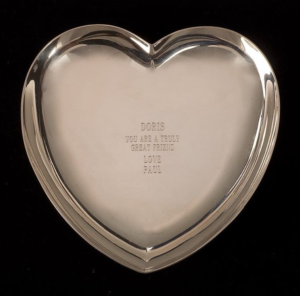
Heart Shaped Dish
Tiffany & Company (founded 1837), 20th century
Sterling silver
Doris Duke was often the most generous to those closest to her. While we do not know the giver of this gift or the reason for such thanks, we can only guess that Miss Duke extended a kindness to “Paul” in a way that was worthy of such a beautiful thank you. The inscription says, “Doris, you are a truly great friend. Love, Paul”. A keepsake of Doris’, this Tiffany & Co. heart shaped dish is stored safely in the collection archives at Rough Point.
Are You Pin-terested?
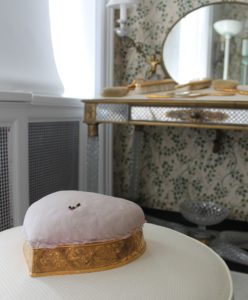
Heart Shaped Pincushion
Tiffany & Company, ca. 1900
18-karat gold base
Another Tiffany & Co. piece from the collection, the base of this heart-shaped pincushion is made of 18-karat gold, while the cushion is made of silk with cotton interior stuffing. It is part of a 14-piece Tiffany dressing set that once belonged to Doris Duke’s mother, Nanaline. Currently it is located in Doris’ personal bathroom in her bedroom at Rough Point, along with rest of the dressing set.
A Dish to Die For

Heart Shaped Dish
ca. 1902
Enamel and copper
Long live the king! This enamel dish with copper latticework is actually a souvenir from the 1902 coronation of British monarchs King Edward VII and Queen Alexandra. It is unknown where Doris Duke acquired it, but this elegant dish also sits in the bathroom of her bedroom at Rough Point.
Want to learn more about the collections at Rough Point? Visit newportrestoration.org/roughpoint/collection or find Newport Restoration Foundation at newportalri.org!
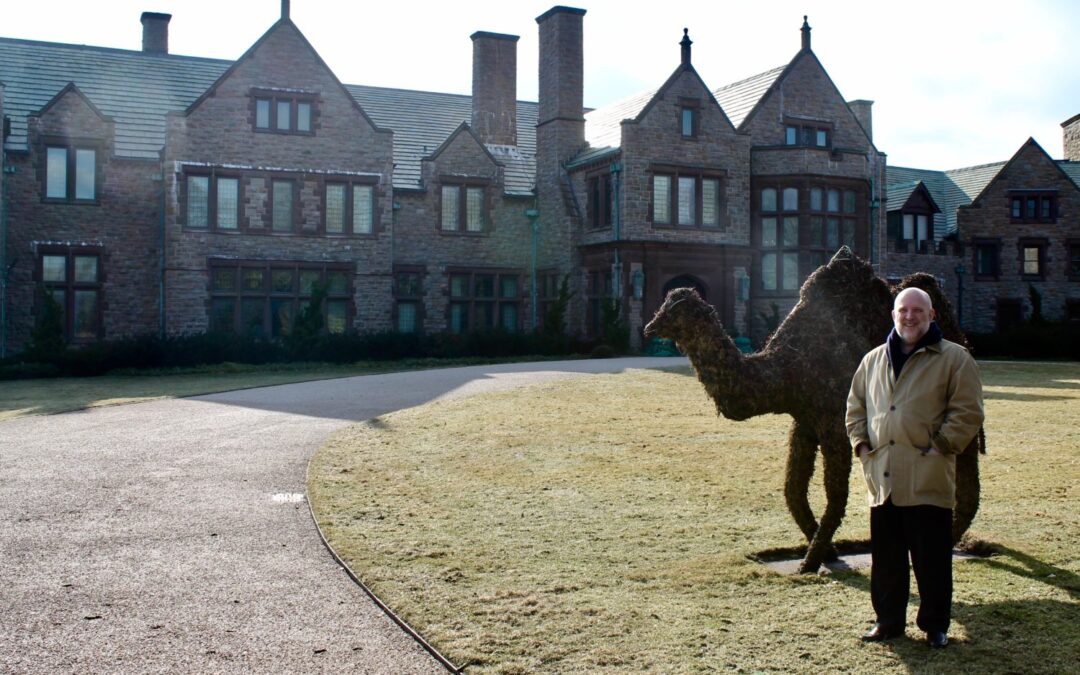
by CC:S MY | Jan 30, 2019 | NRF News
Sometime during my first week serving as the NRF’s Director of Museums, our Marketing Manager suggested that I write an introductory blog post. I said, “Sure, in fact, I think I’ll write two, an introduction and something about my favorite room at Rough Point. And I should have both pieces to you in about two weeks.”
Perhaps the above anecdote gives you some sense of my excitement about serving as the Director of Museums for this unique and significant organization. Others might rightly see in the same story my ability to foolishly bite off more than I can chew. Nevertheless, I promised to introduce myself, which I really should do, so on to the introductions!
I am a public historian and museum professional with some twenty years of experience in the fields of museum education, public programming, departmental leadership, exhibition curation, and other forms of museum practice and historical interpretation. I hold a Ph.D. in American history from UCLA, and I have taught American history, world history, public history, and American Jewish history on numerous campuses across Southern California.
Undoubtedly, my deepest commitment as a scholar and museum professional is to the field of public history, which I would define as the practice of sharing scholarship and other historical practices (historical preservation, for example) with as broad a public as possible. I believe that a general understanding of the work of historians and others in the historical profession is vital to the foundation of a civil society, and I have committed most of my professional life to bridging the gap between working historians and the public. My commitment to public history is very much in keeping with the goals and programming of the Newport Restoration Foundation. Indeed, the Foundation’s mission statement makes clear that it does not simply promote preservation for preservation’s sake, but rather for the “enjoyment, education, and inspiration of all.” Whether you live in an NRF home, visit an NRF museum, or just observe our beautiful restoration work on the streets of Newport, you are learning or experiencing something about the past and the work of those who study and interpret history. Needless to say, I am thrilled to work for an organization that shares my interests and passions in such tangible and clear ways.
Prior to joining the NRF team, I worked the Autry Museum of the American West, an institution dedicated to the history and contemporary culture of the trans-Mississippi West (broadly construed). Over a nearly twenty year career at the Autry, I served as a museum teacher, a public programs manager, curator, and most notably as the Director of Education and Visitor Engagement. As I noted above, much of my practice revolved around making the work of academic historians visible and accessible to the general public, but I also spent a great deal of time building bridges between the museum and the diverse communities of Los Angeles. I instituted an award-winning program that empowered students from grades K-college to curate public history projects that ranged from student art exhibitions to the production of short films, plays, and beyond.
Early on in my career, I brought former gang members, representatives of the LAPD, and western historians to the table to discuss the history of violence in Los Angeles and the broader American West, and over the past decade, I have spent a great deal of time working with California’s diverse Native-American communities. I did so, because I believe deeply in the power of museums and other historical sites to serve as places of learning, engagement, and understanding. To be sure, the museums of the NRF are very different from the sites I worked at in Southern California, but I still believe they have the power to educate, engage, and unite individuals and communities, and I look forward to exploring how we might achieve those ends in Newport and Southern New England.
In addition to my work at the Autry, I have also spent much of the past twenty years doing consultation work for other institutions, pursuing and completing my Ph.D., and teaching in the university classroom (still more examples of my willingness to bite off more than I can chew).
Twenty years is a long time to work at and in one place, but I found the Autry and the scholarly community of Southern California to be a valuable and nurturing training ground and a supportive environment in which to pursue my public history practice. It really took the prospect of working somewhere as special and valuable as the Newport Restoration Foundation to get my wife and I to pick up stakes and move across the country, but we are delighted to be here, and I am thrilled to be the Foundation’s Director of Museums.
To be clear, I am not a complete stranger to the Northeast or New England. I was born in Mt. Auburn Hospital up in Cambridge, MA more years ago than I care to admit, and I was raised in suburban New York, where I lived until 1987. So my new position and new location represent a kind of homecoming for me. There is much in my return to the Northeast that I have found very familiar and very comforting. Yes, I will have to get used to the winter cold again, but I appreciate the eastern greenery (made possible by regular precipitation) as well as the access to real pizza. I look forward to experiencing four seasons (in LA there are only two—hot and less hot with a little rain). I enjoy hearing New England accents. And I appreciate living closer to my family in New York. I will admit that as a New York Giants fan I find it tough to be surrounded by so many Patriots jerseys, but that’s a small price to pay for joining such a wonderful institution and working with such a talented and committed staff.
Those of you who read these blogs will read more from me from time to time (Remember that second blogpost? I still have to write it…), but the truth is that I would rather meet you in person at one of our museums. So when the season begins, please come to Rough Point, Whitehorne House Museum, or Prescott Farm. You might find me walking around. In fact, I spent most of my first Friday morning on the job walking the grounds of all three sites, and I loved it! If you would really would like to meet me, send me an e-mail and let me know you’re coming. I will do my best to find the time to say hello. You can reach me at Erik@newportrestoration.org
See You in Newport!
By Erik Greenberg, Ph.D., Director of Museums, Newport Restoration Foundation
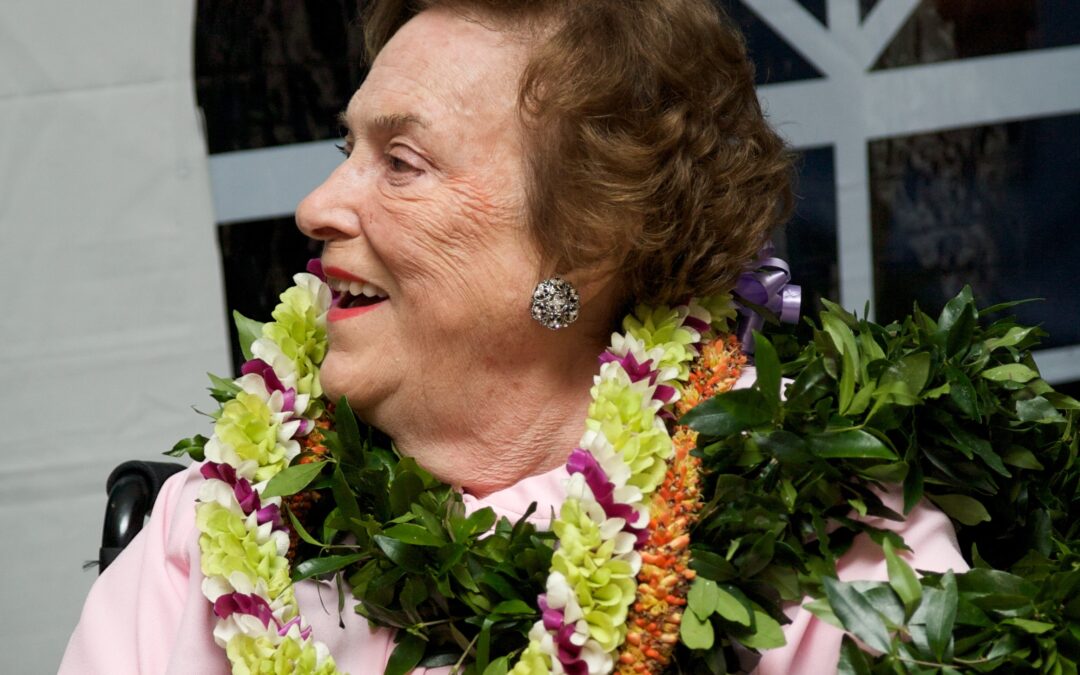
by CC:S MY | Dec 20, 2018 | NRF News
Newport Restoration Foundation is deeply saddened by the recent passing of our Chair Emerita, Mrs. Marion Oates “Oatsie” Charles on December 5, 2018. Mrs. Charles was the longest serving NRF board member, serving for 37 years (1977-2014). For many of those years, the NRF board consisted of founder Doris Duke, Jackie Kennedy, Alletta Morris McBean, and later, J. Carter Brown. Mrs. Charles served as President of the Board of Trustees, and was a dear friend of Doris Duke.
In her will, Doris Duke named Mrs. Charles as one of two trustees for the Doris Duke Charitable Foundation. She served on the DDCF board from its founding in 1996, including as its Vice Chairman. She was named Trustee Emerita in 2008.
In 2010, Mrs. Charles received the Distinguished Steward Award at the Doris Duke Historic Preservation Awards in recognition of her support for preservation in Newport and Washington, D.C. She was also one of the driving forces behind the remodel of Queen Anne Square in Newport, spearheading the effort to hire Maya Lin to design “The Meeting Room,” as a public tribute to Doris Duke.
The Newport Restoration Foundation and the broader Newport community has lost a valued member and leader. Mrs. Charles was beloved by all for her dedication, graciousness and sense of humor. NRF would like to recognize Mrs. Charles for her significant contributions and service, and will continue to celebrate her as a tireless advocate for preservation in Newport. Thank you, Mrs. Charles.
The family plans a memorial service in Newport in June. We are honored that, in lieu of flowers, the family requests donations be made to the Newport Restoration Foundation.
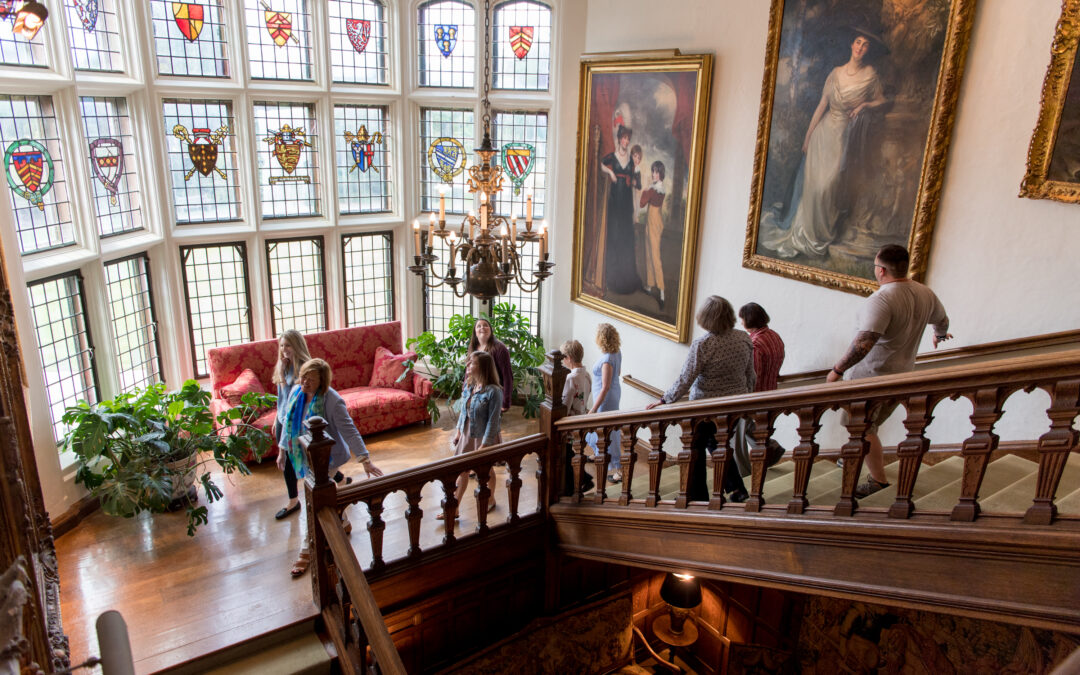
by CC:S MY | Sep 4, 2018 | NRF News
This October officially marks the 50th anniversary of the Newport Restoration Foundation, so we’re opening our doors to the community with special events, including FREE admission to Rough Point on October 24 to celebrate our Golden Birthday. This entire year we’ve been looking back at — and sometimes reviving — what Doris Duke and others were up to around the time of its founding. Please mark your calendars for special events across all of our museum locations including:
Newport Schools Night
Rough Point
September 19 / 5:00 – 7:00 pm / Free
Tucked all the way at the end of Bellevue, Rough Point is easy to miss. All Newport K-12 students and their families are invited to visit Doris Duke’s eccentric home for a night of fun and exploration. The museum and grounds will be open for strolling. Lawn picnics and #camelgrams encouraged. All ages welcomed. Ages 18 and under are free, and adults admitted free if accompanied by a K-12 student. Otherwise, general admission is $10.
A Closer Look at Designing for Doris, Curators Tour & Open House
Rough Point
September 20 / 4:30 – 7:00 pm / Free
David Webb archivists Dianne Batista and Levi Higgs will explore the intersecting interests of David Webb and Doris Duke in this special tour of Designing for Doris: David Webb Jewelry and Newport’s Architectural Gems. The tour will touch on the curatorial process and the commitment to beauty and design that drew two creative minds together. Tours will be held at 4:30, 5:30 & 6:30 (advance registration required). Light refreshments served at the open house to follow, which is free and open to the public. This is a Design Week RI event.
Ask a Gardener
Rough Point
September 29 & October 27 / 11:00 am, weather permitting
Included with admission to the house or grounds
Every last Saturday of the month, estate gardeners share their expertise on a range of topics from plant identification to organic garden care. Get insider tips on how to make your own garden as lush as the gardens at Rough Point.
Gardening with the Masters: Colonial Foodways of New England
Prescott Farm
October 7 / 10:00 am – 12:00 pm, Lecture begins at 11:00 am
Free Event
Whether you’re growing lettuce or lupines, the URI Master Gardeners are here to help! At 11:00 am hear garden pros speak on selected topics. This month, learn about “Colonial Foodways of New England” with Jeff Richards. The 1812 Sherman Windmill is also open for touring.
Stone Wall Workshop
Prescott Farm
October 13 / 9:30 am – 12:30 pm
$40, Advance registration required
Learn the art of traditional stone wall construction and repair from the experts. Join Master class instructors Chris and Dan Smith for their fifteenth year leading this hands-on workshop. Light snacks and refreshments will be provided for all participants. If you have work gloves, please bring them along. Please note: In the event of bad weather, the rain date is October 14.
NRF’s Golden Birthday
October 24 / Free
In October 1968, the Newport Restoration Foundation was officially incorporated – 50 years later we invite Newport to celebrate the work that’s been accomplished and the exciting road ahead.
9:30 am – 7:00 pm
Rough Point, 680 Bellevue Avenue
Admission to Rough Point, Doris Duke’s Newport home and the site of the earliest NRF’s annual board meetings, is free all day.
5:00 – 7:00 pm
Vernon House, 46 Clarke Street
Vernon House, one of the newest additions to NRF’s collection of 18th century buildings, will be open to the public for an evening of community and celebration. Drop in to say hello, explore one of Newport’s most fascinating buildings, and toast to the next 50 years! Light refreshments will be served. Advance registration required here.
Workshopping the Collection: Newport’s Cabinetmaking Tradition
Whitehorne House Museum
October 14 / 1:00 – 3:00 pm
$50; advance registration required
Get up close and personal with the early American furniture collection at the Whitehorne House Museum. Jeffrey Greene will be turning his craftsman’s eye to the construction details and design differences that set Newport furniture apart. Expect hands-on experience and careful examination during this seminar-style workshop. We’re turning tables upside-down, removing drawers, and getting on hands and knees to study the distinct form of Newport ball-and-claw feet.
Workshopping the Collection: Identifying Legendary Newport Cabinetmakers
Whitehorne House Museum
October 28 / 1:00 – 3:00 pm
$50; advance registration required
Jeffrey Greene will be turning his craftsman’s eye to the minute details of a piece that help to identify the maker. Only a tiny percentage of high-end Newport furniture is signed or labeled, but craftsman’s markings and methods of work are as identifiable as handwriting and have yielded some surprising discoveries. Expect hands-on experience and careful examination during this seminar-style workshop.
Colonial Survival and Modern Revival: Newport in the 1960s
Rough Point
October 30 / 5:00 – 7 :00 pm / $15
Newport in the 1960s was a time-worn place, a city of many architectural layers. Some saw decay; others saw a sleeping beauty. Urban renewal celebrated modernity, and historic preservation revered the past. These two forces were engaged in an epic battle for the future of the city. Through period photographs and compelling news reports, journey back to the old colonial districts of the Historic Hill and Point and witness the explosive firmament of the 1960s when an important chapter in Newport’s history was being written. Doors will open at 5:00; the lecture begins at 5:30. We invite you to visit the special exhibition galleries before the program.
For more information on all events, visit www.NewportRestoration.org/events.




 Humidor, Wilke Manufacturing Company, Anderson, Indiana (American, 1897-1905). United States, ca. 1900. Porcelain tiles, nickel, wood, P2018.1.
Humidor, Wilke Manufacturing Company, Anderson, Indiana (American, 1897-1905). United States, ca. 1900. Porcelain tiles, nickel, wood, P2018.1.








